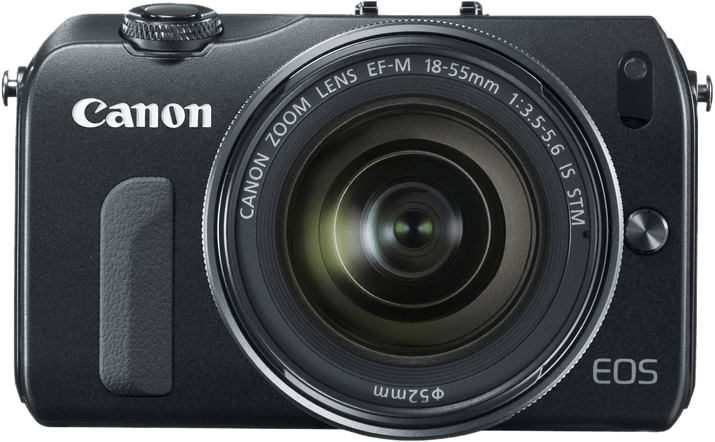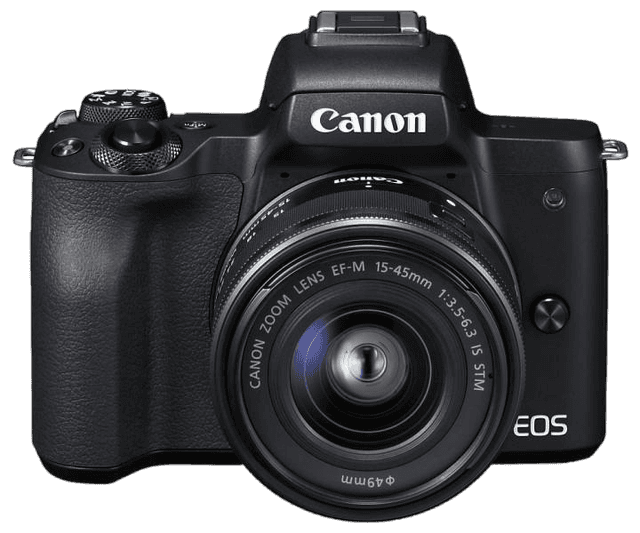Canon EOS M vs EOS M50 Comparison
Canon EOS M

Canon EOS M50

The Canon EOS M50 takes the lead with a score of 59/100, while the Canon EOS M trails behind with a 44/100 score. Both cameras are mirrorless and share similarities in launch price, with the EOS M50 priced at $779 and the EOS M at $799. However, there are notable differences in their specifications.
The EOS M50 has advantages over the EOS M, including its more recent release year (2018) and improved features. On the other hand, the EOS M, released in 2012, is lighter at 298g (0.66lbs) and has a smaller body measuring 109 x 66 x 32mm, making it more compact and portable.
Taking these factors into consideration, the Canon EOS M50 emerges as the better camera due to its updated features and higher score. However, the Canon EOS M may appeal to those seeking a more lightweight and compact option.
Canon EOS M vs EOS M50 Overview and Optics
The Canon EOS M50 outperforms the Canon EOS M in optics, scoring 59/100 compared to the EOS M’s score of 42/100. Both cameras share several specifications, including a CMOS sensor type, APS-C sensor size, Canon EF-M lens mount, and lack of image stabilization.
The EOS M50 surpasses the EOS M in megapixels, offering 24 compared to the EOS M’s 18. This results in higher image resolution, providing greater detail and improved image quality. Additionally, the EOS M50 boasts a significantly faster shooting speed of 10 frames per second (fps) compared to the EOS M’s 4.3 fps. This allows for capturing fast-moving subjects and rapid action shots with ease. Furthermore, the EOS M50 features a more advanced processor, the Digic 8, which contributes to better image processing and overall performance.
On the other hand, the Canon EOS M has a higher DXOMARK score for its sensor, scoring 65 points compared to the EOS M50’s 58 points. This indicates that the EOS M may produce better image quality in certain situations, despite its lower megapixel count.
Taking these factors into account, it is clear that the Canon EOS M50 offers superior optics performance in terms of resolution, shooting speed, and processing power. However, the EOS M’s higher DXOMARK sensor score highlights its potential for quality images under specific conditions. Ultimately, the Canon EOS M50 is the better choice for those seeking improved optics performance, while the Canon EOS M may suit those who prioritize sensor quality over other factors.
Canon EOS M vs EOS M50 Video Performance
The Canon EOS M50 outperforms the Canon EOS M in video capabilities with a significant difference in scores: 91/100 for the M50 and 43/100 for the EOS M. Despite the gap in scores, both cameras share some common video specifications. They both offer Full HD video resolution and have maximum video dimensions of 1920 x 1080. Additionally, both cameras have a maximum video frame rate of 30fps.
However, the Canon EOS M50 excels in several aspects that make it a superior choice for video. The M50 has a maximum video resolution of 4K, allowing for higher quality and more detailed footage. Its maximum video dimensions are 3840 x 2160, providing a larger and more immersive viewing experience. Furthermore, the EOS M50 has a higher maximum video frame rate of 120fps, enabling smoother slow-motion playback. The M50 also includes a built-in time-lapse functionality, adding versatility to its video capabilities.
On the other hand, the Canon EOS M does not offer any notable advantages over the EOS M50 in terms of video capabilities. Its lower score reflects its limitations and the absence of features like 4K resolution, higher frame rates, and time-lapse functionality.
Taking these factors into account, the Canon EOS M50 is the clear winner in terms of video capabilities. Its higher score is indicative of its superior features, such as 4K resolution, higher frame rates, and built-in time-lapse functionality. In contrast, the Canon EOS M falls short in these areas, making it a less suitable choice for those seeking advanced video capabilities.
Canon EOS M vs EOS M50 Features and Benefits
The Canon EOS M50 emerges as the winner with a feature score of 70/100, compared to the Canon EOS M’s score of 57/100. Examining the specifications of both cameras reveals their similarities and differences, helping to understand why the M50 has a higher score.
Both cameras share a 3-inch touchscreen with a screen resolution of 1,040,000 dots. Neither camera has GPS functionality. These common features establish a baseline for comparison.
The EOS M50’s higher score can be attributed to its additional features, such as a flip screen, Wi-Fi, and Bluetooth connectivity. The flip screen allows for more versatile shooting angles and is particularly useful for vlogging or taking selfies. Wi-Fi and Bluetooth capabilities enable easy sharing and transfer of photos, as well as remote control of the camera through a smartphone or tablet.
On the other hand, the EOS M does not offer any significant advantages over the M50. It lacks a flip screen, Wi-Fi, and Bluetooth connectivity, which limits its overall functionality and convenience in comparison to the M50.
Considering these points, the Canon EOS M50 is the better camera in terms of features, offering greater versatility and connectivity options. Its flip screen, Wi-Fi, and Bluetooth capabilities make it more user-friendly and adaptable to various shooting situations. The Canon EOS M, while sharing some basic features with the M50, falls short in offering the same level of convenience and functionality due to its lack of additional features.
Canon EOS M vs EOS M50 Storage and Battery
The Canon EOS M and the Canon EOS M50 both score 13/100 in storage and battery, indicating a tie in this category. Both cameras have a single memory card slot and accept SD, SDHC, and SDXC memory cards. However, the EOS M50 is compatible with UHS-I cards, providing faster transfer speeds.
In terms of battery life, the EOS M50 has a slight advantage with 235 shots per charge, while the EOS M provides 230 shots. Both cameras use the same LP-E12 battery type. Neither camera supports USB charging.
Despite the EOS M50’s UHS-I compatibility and marginally longer battery life, both cameras perform similarly in storage and battery capabilities. Users of either camera can expect adequate performance in these areas, with no significant differences to impact their overall experience.
Canon EOS M vs EOS M50 – Our Verdict
Are you still undecided about which camera is right for you? Have a look at these popular comparisons that feature the Canon EOS M or the Canon EOS M50:
